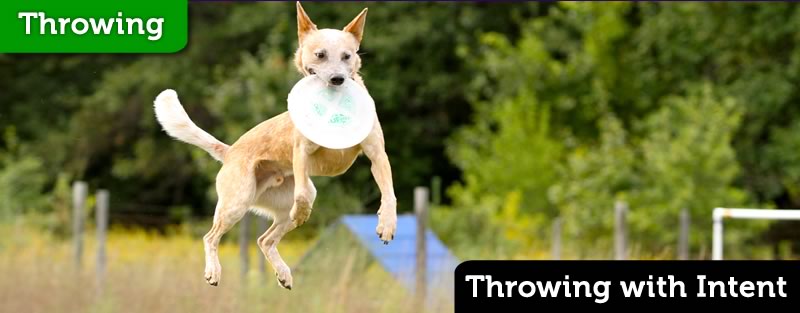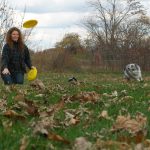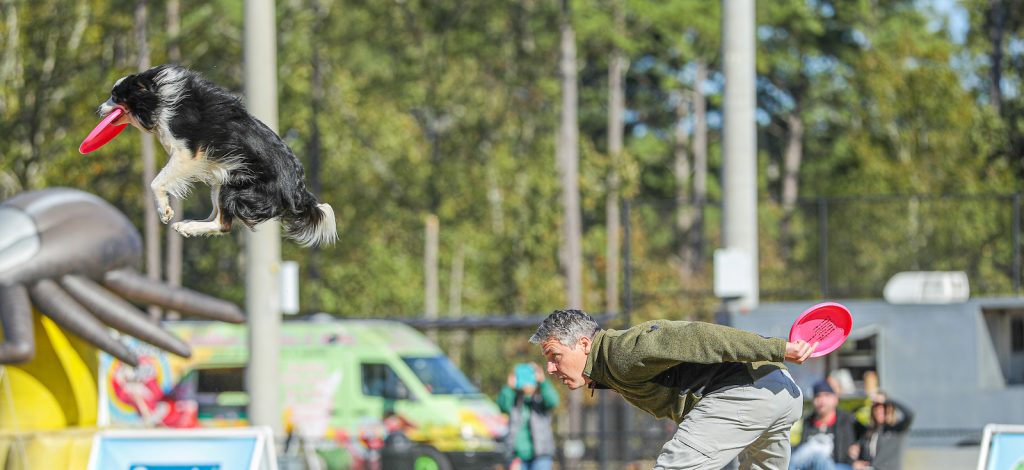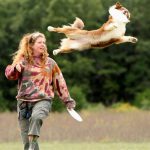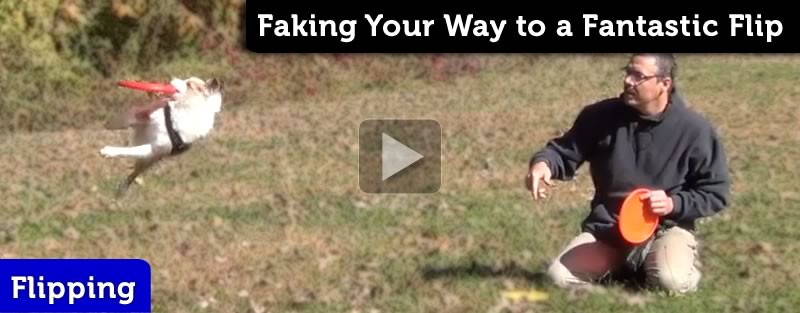
Are You Flippin’ Kidding Me? Faking Your Way to a Flip
Taz is the baby of CJ’s pack you can tell if you hang out with them for a while.
One of the things that is very difficult is shifting gears from that puppy game where criteria is low and flexible and the reinforcement is freeflowing and effusive to a more adult kind of game where the criteria is higher and reinforcement is more of a challenge. CJ is throwing extremely low and is quite tentative in her approach, lest she break the baby.
Flips Have Scale
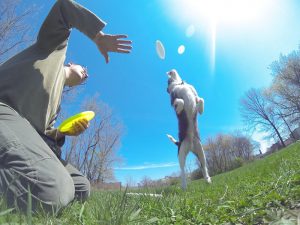 Right before your dog flips, as he leaves the ground, he is essentially “sitting pretty” or “begging” – standing upright front feet off the ground on his haunches. In this position the dog’s head, even with a little guy like Taz here is 18″ off the ground. For normal sized dogs, the height of the head might be 30 or 36″ – that’s chest high.
Right before your dog flips, as he leaves the ground, he is essentially “sitting pretty” or “begging” – standing upright front feet off the ground on his haunches. In this position the dog’s head, even with a little guy like Taz here is 18″ off the ground. For normal sized dogs, the height of the head might be 30 or 36″ – that’s chest high.
CJ is throwing too low here, keeping Taz from lifting and extending to grab the target. This means that there is not as much time as possible to make the catch and dial in a landing.
Make sure the disc is placed high enough to require a leap.
Leaping for the Target vs Leaping to a Spot
CJ is a bit wide on her throws here, but it’s not at all bad. Taz should be able to make the correction, but cannot because he is committed to a spot Spot is a “go to a place”, or “go to a mat” behavior. This means that the dog seeks out and performs a duration behavior on a spot of the handler’s choosing. A... More instead of committed to the target. Taz knows exactly where that disc is going to be, or Taz has been reinforced for a particular athletic position, but it doesn’t really matter, the end result is the same: Taz leaps to the spot and if the disc is not in that spot it cannot touch his teeth so it is uncatchable.
Spot is a “go to a place”, or “go to a mat” behavior. This means that the dog seeks out and performs a duration behavior on a spot of the handler’s choosing. A... More instead of committed to the target. Taz knows exactly where that disc is going to be, or Taz has been reinforced for a particular athletic position, but it doesn’t really matter, the end result is the same: Taz leaps to the spot and if the disc is not in that spot it cannot touch his teeth so it is uncatchable.
You can see this clearly when we start to fake him out. Because he had committed to the flipping behavior and totally ignored the target, he literally has no idea where the disc went. A few reps of faking him out and we were looking at a different skill and different focus of effort.
After faking him out a couple of times, Taz started to leap for the target, getting a couple of catches and putting out some fine effort.
Clock or Counter
CJ was flipping clockwise, using her right hand and throwing an inverted backhand. I chose to flip him the other way, counter clockwise, using a simple right handed backhand throw. I believe he is stronger in the clockwise direction, although he seems pretty well balanced. Make sure to teach flips to the dog’s strong side, and not the side most convenient for the handler. The throws are tiny and simple, make sure the dog has the easy job here.
Apex Trajectory
CJ’s discs were low in terms of placement, but they were also low in terms of trajectory. Her tosses just arc down, there’s not enough stall or hover in their trajectory to ask Taz to get up and take the disc. You’ll notice that Taz just beasted all over that flip for a take, right? That was a trajectory that has an apex — a point, a top — that is a prime moment for your dog to be snatching that disc.
Keeping Focus and Keeping the Flow
Taz has some engagement issues, as you can see in the video. I shifted gears from flipping to dropping and rollers to keep Taz engaged. I also blew off some criteria on his dropping and chewing issue. This session was about flipping, not dropping.





